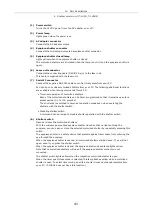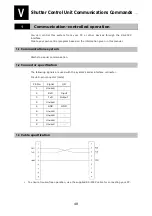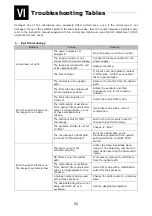
52
Troubleshooting Tables
VI
Improper use of the microscope may adversely affect performance, even if the microscope is not
damaged. If any of the problems listed in the table below arise, take the countermeasures indicated. Also
refer to the instruction manual supplied with the microscope, light source and the DIC attachment (If DIC
attachment is also used).
1. Epi-fl
microscopy
Problem
Cause
Remedy
The power supply is not
plugged in.
Plug the power cord into an outlet.
The lamp connector is not
connected to the power supply.
Connect the lamp connector to the
power supply.
The lamp has reached the end
of its operational life.
Replace the lamp.
Lamp does not light.
The fuse is blown.
If the fuse can be replaced, replace
it. Otherwise, contact your nearest
Nikon representative.
The shutter is in the optical
path.
Remove the shutter from the optical
path.
The filter cube has stopped at
an intermediate position.
Rotate the excitation method
changeover ring to the clickstop
position.
The filter cube selection is
incorrect.
Select the correct filter cube.
The combination of excitation
filter, barrier filter and dichroic
mirror is inappropriate, or one
of these components is
missing.
Use a filter cube with a correct
combination.
The setting is still for TIRF
microscopy.
Push in the mirror switch lever to
change to Epi-fl microscopy.
The eyepiece shutter is not set
to “Bino” .
Change to “Bino” .
Even though the lamp is on,
the image is not visible.
The microscope’s optical path
is not set to “Observation” .
Point the optical path at the
binocular eyepiece with the optical
path switch knob or LIGHT PATH
switch.
The light source is not
centered properly.
Center the lamp. Especially when
using a 100x objective, recenter the
lamp while observing the fluorescent
image.
ND filters are in the optical
path.
If necessary, remove the ND filters
from the optical path.
The combination of excitation
filter, barrier filter and dichroic
mirror is inappropriate for the
specimen.
Use a filter cube with a combination
suited for the specimen.
A halogen lamp is being used
with a dark specimen.
Change the light source to a mercury
lamp.
Even though the lamp is on,
the image is extremely dark.
The designated objective is not
being used with UV or V
excitation.
Use the designated objective.
Summary of Contents for TIRF2
Page 1: ...TIRF2 SYSTEM FOR TE2000 INSTRUCTIONS M339E 04 12 NF 2 ...
Page 2: ......










































